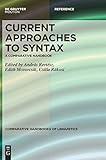Current Approaches to Syntax : A Comparative Handbook / ed. by András Kertész, Edith Moravcsik, Csilla Rákosi.
Material type: TextSeries: Comparative Handbooks of Linguistics [CHL] ; 3Publisher: Berlin ; Boston : De Gruyter Mouton, [2019]Copyright date: ©2019Description: 1 online resource (XVI, 600 p.)Content type:
TextSeries: Comparative Handbooks of Linguistics [CHL] ; 3Publisher: Berlin ; Boston : De Gruyter Mouton, [2019]Copyright date: ©2019Description: 1 online resource (XVI, 600 p.)Content type: - 9783110538212
- 9783110538373
- 9783110540253
- 410.5 19/eng/20230216
- P291 .C87 2019
- P291 .C87 2019
- online - DeGruyter
- Issued also in print.
| Item type | Current library | Call number | URL | Status | Notes | Barcode | |
|---|---|---|---|---|---|---|---|
 eBook
eBook
|
Biblioteca "Angelicum" Pont. Univ. S.Tommaso d'Aquino Nuvola online | online - DeGruyter (Browse shelf(Opens below)) | Online access | Not for loan (Accesso limitato) | Accesso per gli utenti autorizzati / Access for authorized users | (dgr)9783110540253 |
Frontmatter -- Acknowledgment -- Contents -- Biographical Sketches -- 1. Introduction -- Part I: Approaches to syntax -- 2. Cognitive Grammar -- 3. Construction Grammar -- 4. Simpler Syntax -- 5. Lexical Functional Grammar -- 6. The Decathlon Model -- 7. The Stupendous Success of the Minimalist Program -- 8. The Parallel Architecture -- 9. Usage-based Grammar -- 10. Optimality-theoretic Syntax -- 11. The Functional Discourse Grammar approach to syntax -- 12. Head-Driven Phrase Structure Grammar -- 13. Dependency Grammar -- 14. Combinatory Categorial Grammar -- Part II: Metatheoretical foundations -- 15. Syntactic knowledge and intersubjectivity -- 16. Hermeneutics and generative linguistics -- 17. The uncertainty of syntactic theorizing -- 18. The multiparadigmatic structure of science and generative grammar -- 19. The philosophy of generative linguistics: best theory criteria -- 20. The research programme of Chomskyan linguistics -- 21. Conclusions: On the use of the comparison of syntactic theories -- Author Index -- Language Index -- Subject Index
restricted access online access with authorization star
http://purl.org/coar/access_right/c_16ec
Even though the range of phenomena syntactic theories intend to account for is basically the same, the large number of current approaches to syntax shows how differently these phenomena can be interpreted, described, and explained. The goal of the volume is to probe into the question of how exactly these frameworks differ and what if anything they have in common.Descriptions of a sample of current approaches to syntax are presented by their major practitioners (Part I) followed by their metatheoretical underpinnings (Part II). Given that the goal is to facilitate a systematic comparison among the approaches, a checklist of issues was given to the contributors to address. The main headings are Data, Goals, Descriptive Tools, and Criteria for Evaluation. The chapters are structured uniformly allowing an item-by-item survey across the frameworks. The introduction lays out the parameters along which syntactic frameworks must be the same and how they may differ and a final paper draws some conclusions about similarities and differences.The volume is of interest to descriptive linguists, theoreticians of grammar, philosophers of science, and studies of the cognitive science of science.
Issued also in print.
Mode of access: Internet via World Wide Web.
In English.
Description based on online resource; title from PDF title page (publisher's Web site, viewed 25. Jun 2024)


